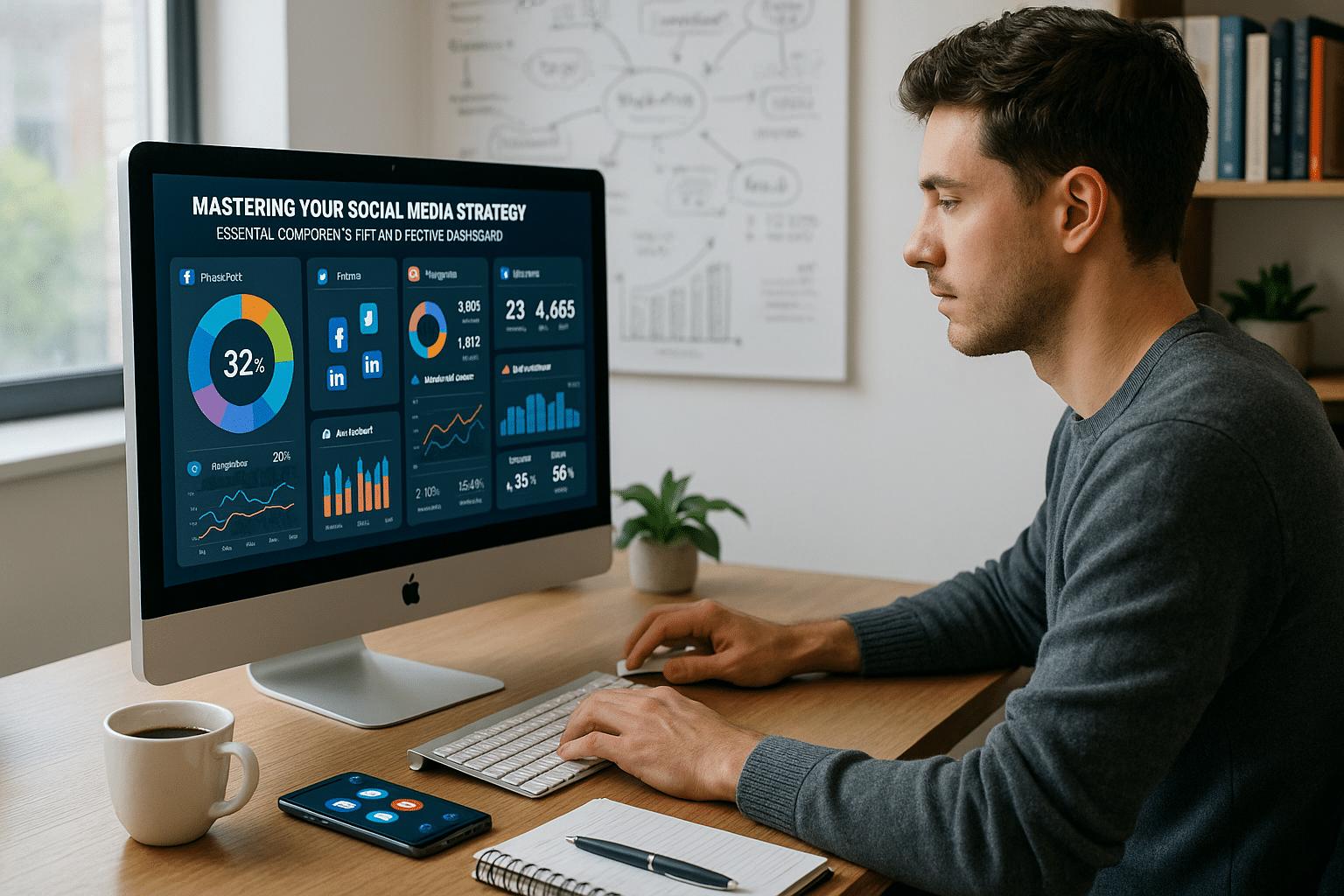It’s overwhelming, to say the least. 😅 Even for the most social media-savvy amongst us, trying to effectively manage, monitor, and measure our social media efforts can be a Herculean task. Enter: Social Media Dashboard. But what constitutes an effective dashboard? Let’s dive in!
Imagine a unified platform that allows you to track, analyze, and interpret your social media performance all in one place. A platform that lets you streamline your efforts, gain insights into your audience behavior, and make data-driven decisions. 🔍 This, in essence, is what a well-built social media dashboard is about.
What We’re Covering
In this comprehensive guide, we’ll break down the essential components of a social media dashboard and how you can master them to supercharge your social media strategy. By the end of this read, you’ll have a firm grasp on the building blocks of an effective dashboard and how to leverage them to your advantage.
The Importance of a Social Media Dashboard
The first thing we’ll delve into is why a social media dashboard is integral to your online strategy. We’ll discuss how it can help you save time, streamline your workflow, and provide you with crucial insights into your performance across different platforms. 📊 We’ll also look at how a dashboard can help you monitor your brand’s online presence and reputation, and allow you to respond promptly to comments or queries.
Key Elements of a Social Media Dashboard
Next, we’ll explore the core components that make up an effective social media dashboard. From tracking tools and analytics features to integration capabilities and reporting functions, we’ll dissect each component, illustrating their roles and how they contribute to a well-rounded strategy.
Customization and Integration
Then, we’ll delve into the importance of customization and integration in a social media dashboard. After all, one size doesn’t fit all, especially in the ever-evolving realm of social media. We’ll discuss how to tailor your dashboard to your specific needs and how to integrate it with other tools to maximize efficiency and effectiveness.
Data Analysis and Reporting
Finally, we’ll examine how a social media dashboard can facilitate data analysis and reporting. We’ll look at how to interpret the data your dashboard provides and how to translate these insights into actionable strategies. Moreover, we’ll explore how to present this data in visually appealing and easily digestible reports, aiding you in communicating your results and strategies to your team or stakeholders. 👥
Armed with this knowledge, you’ll be well on your way to creating a social media dashboard that not only simplifies your workflow but also provides valuable insights into your strategy’s effectiveness. So let’s roll up our sleeves and dive into the nitty-gritty of mastering your social media dashboard.
Understanding Social Media Strategy
The field of social media marketing is continuously evolving, requiring businesses to keep pace with the changing dynamics. Understanding the necessity of an effective social media strategy is an essential step in establishing a strong online presence and maintaining a substantial consumer base. A sound social media strategy is not merely about posting content; it involves in-depth analysis of market trends, understanding the target audience, and crafting a message that resonates with them.
The backbone of an effective social media strategy is a well-designed dashboard. A social media dashboard is an interface that allows businesses to manage and analyze their social media presence effectively. It offers insights into user behaviors, market trends, and the performance of various posts and campaigns. This article will break down the essential components of a social media dashboard and how to leverage them to master your social media strategy.
Before we delve into the specifics, I encourage you to watch this insightful video titled “How to Create a Social Media Strategy in 8 Easy Steps” by the YouTube channel Hootsuite. It provides an excellent overview of the strategic planning process and will set the foundation for the details we’ll explore later in the article.
Essential Components of a Social Media Dashboard
An effective social media dashboard needs to have certain components that allow for comprehensive analysis and effective management. These components are typically divided into two categories: monitoring and analytics.
Under monitoring, you’ll find tools that allow you to keep track of your brand’s online presence, sentiment, and engagement levels. This includes social listening tools, real-time notifications, sentiment analysis, and influencer tracking.
The analytics component provides insights into the performance of your social media strategy. It includes metrics tracking, competitive analysis, audience insights, and campaign performance reports.
Monitoring Tools
Social listening tools are crucial in understanding your brand’s reputation online. These tools analyze the conversations happening around your brand, helping you gauge public sentiment and respond promptly. Real-time notifications alert you of any significant activity or engagement on your social media channels, ensuring that you are always aware of your brand’s online performance. Sentiment analysis tools assess the public’s feelings towards your brand by analyzing the tone of the conversations happening online. Influencer tracking is a tool that helps you identify influential individuals within your industry, allowing you to leverage their reach to boost your brand’s visibility.
Analytics Tools
Metrics tracking provides data on key performance indicators (KPIs) such as likes, shares, comments, and follower growth. Competitive analysis tools offer insights into your competitors’ social media strategies, helping you understand their strengths and weaknesses. Audience insights tools provide demographic and behavioral data about your followers, enabling you to tailor your content to meet their needs. Campaign performance reports offer detailed analysis of your marketing campaigns, helping you understand what worked and what didn’t.
Mastering Your Social Media Strategy with an Effective Dashboard
Having a social media dashboard with the right tools is only half the battle. You also need to know how to leverage these tools to maximize your social media strategy’s effectiveness. Here are a few strategies that can help you master your social media strategy using an effective dashboard.
Identifying Trends and Patterns
An effective dashboard will help you identify trends and patterns in your social media data. This could include times when your audience is most active, content types that resonate most with your followers, and sentiments associated with your brand. Identifying these trends will help you tailor your strategy to maximize engagement and conversions.
Setting and Tracking Goals
A dashboard will also help you set and track your social media goals. You can set specific KPIs, such as follower growth, engagement rate, or conversion rate, and track your progress towards these goals using your dashboard. This will not only help you stay focused on your objectives but also allow you to make necessary adjustments to your strategy if you’re falling short of your goals.
Evaluating and Adjusting Your Strategy
Lastly, your dashboard should help you evaluate your social media strategy’s effectiveness. By analyzing the performance of your campaigns and posts, you can identify areas where your strategy is falling short and make necessary adjustments. This could involve tweaking your content strategy, adjusting your posting schedule, or revising your targeting approach.
In conclusion, a well-designed social media dashboard is an essential tool for mastering your social media strategy. By providing a comprehensive overview of your online presence and offering actionable insights, it can help you create and maintain an effective social media strategy. Remember, the key to mastering your social media strategy is not just about having the right tools, but also about knowing how to use them effectively.
Comparing Social Media Dashboards
There are numerous social media dashboards available on the market, each offering a unique set of features. It’s crucial to choose a dashboard that fits your business’s needs and aligns with your social media strategy. To help you make an informed decision, here’s a comparative table of some of the popular social media dashboards.
| Dashboard | Features | Pros | Cons |
|---|---|---|---|
| Hootsuite | Social listening, analytics, scheduling | Easy to use, comprehensive features | Limited free version |
| Buffer | Scheduling, analytics, team collaboration | User-friendly, robust analytics | Limited social listening features |
| Sprout Social | Social listening, analytics, customer engagement | Powerful analytics, great for customer service | Expensive |
For an in-depth review of these dashboards, check out this video titled “Best Social Media Management Tools (2021)” by the YouTube channel AppSumo. It provides a thorough comparison and review of the top social media management tools available on the market.

Conclusion
In summary, we have delved deep into the realms of IT and software engineering, meticulously dissecting and explaining complex concepts in a simplified manner. My aim has always been to present technical jargon in a digestible form, without compromising the depth and accuracy of the information.
Throughout this article, we have explored the intricate connection between IT and engineering, examining how the two distinct fields intersect and influence one another. We have unpacked the role of software engineering in shaping the digital landscape, understanding its crucial position in creating and maintaining the systems that underpin our digital world. Furthermore, we have also discussed the impact of evolving technologies, such as artificial intelligence and machine learning, on the future of software engineering.
The significance of this topic cannot be understated. As we progress further into the digital age, understanding the technicalities of IT and engineering is no longer a luxury, but rather a necessity. With every passing day, our lives become more intertwined with technology, heightening the need for robust and efficient systems. This is where the value of software engineering is truly realised.
I encourage each one of you to immerse yourselves in the sea of knowledge that surrounds these areas. Comment below with your thoughts and experiences, share this article with your peers, and apply the lessons learnt in your own professional journey.
Remember, learning is a never-ending process, and every concept understood, no matter how complex, is a step towards becoming a better professional. 😊
To further enhance your knowledge, I would recommend some additional resources:
1. [Intro to Information Technology](https://www.coursera.org/learn/intro-to-it) – Coursera
2. [Software Engineering: Introduction](https://www.edx.org/professional-certificate/introduction-to-software-engineering) – EdX
3. [Machine Learning](https://www.coursera.org/learn/machine-learning) – Coursera
Make sure to revisit these sources periodically to keep up with the constant changes in the tech world.
I hope you found this article beneficial and I look forward to engaging with you in future discussions. Your feedback is valuable and greatly appreciated. Together, let us navigate the technical world, one concept at a time. 👩💻🌐👨💻
References
- Coursera. (n.d.). Intro to Information Technology. [Online] Available at: https://www.coursera.org/learn/intro-to-it (Accessed: Date)
- EdX. (n.d.). Software Engineering: Introduction. [Online] Available at: https://www.edx.org/professional-certificate/introduction-to-software-engineering (Accessed: Date)
- Coursera. (n.d.). Machine Learning. [Online] Available at: https://www.coursera.org/learn/machine-learning (Accessed: Date)



